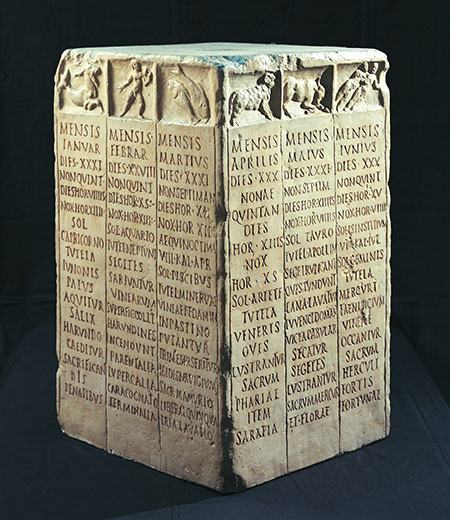
Considering how nature is cyclical, which makes it difficult to specify when anything really begins, how is it that most of the world runs by a linear calendar system? Why do we even have the New Year we have? How did we come to have this civil dating system?
The calendar most of the world uses today is the solar-based Gregorian Calendar, previously being the Julian Calendar, which was preceded by the lunar based Roman Calendar that began over 2700 years ago.
And this is how it happened and what dilemmas arose with it.
THE YEAR
In early human history, the changes in the environment were kept track of through oral lessons of signs in nature. Over time the number of days between major reoccurring environmental changes became counted, forming a year.

The counting of a year most commonly began anew after the dormant period, though some prominent cultures began counting from the beginning of the dormant period. For most of human history the year was based on lunar cycles which made up the months. Every 3 years or so, depending on the calendar structure, a whole month had to be added just to keep the seasons lined up with the dates. This way of keeping track helped people with the timing of the seasons: when to plant and harvest, when to move the herd, or when to follow migratory animals. Solar based years were later developed and were more accurate in comparison, yet few calendars were solar based in human history because it was harder to measure than the more easily recognizable cycles of the moon.
The years gone by or to come were not dated and remained so for quite some time. The early beginnings of dating years emerged in the form of naming the years after the ruling head of the lands. This was done to keep records organized and easy to reference, especially for trade and legal purposes. It also becomes the first time when histories become accurately retraceable as opposed to being only recounted orally through memorization; which is highly susceptible to becoming altered by views of the current times it is retold in (A relatable example of this is the tale of Robin Hood. The bow and arrow aspect was added much later when it became a popular sport among the commoners).
THE ROMAN MONTHS

Cast from the original, ca. 1930
Rome, Museo della Civiltà Romana, inv. M.C.R. n. 3485
The early Roman Calendar year consisted of 10 months totaling 304 days, the dormant period being considered a month-less period where about 61 days were uncounted. The Romans also had a name for the first day of every month. It was known as the “kalends.” It’s from this word that our word calendar is derived. The year began in spring at the vernal equinox on the first of what we currently know as March (at the time of founding the Roman Calendar it would have went by a different name that meant “month 1”, but this name has been lost to history). The first day of the year was very important to the city of Rome because that is when new consuls were sworn into office. The week on a Roman Calendar was 8 days long, called a Market Week because market day was on the last/first day of the week. This was because the Romans counted inclusively (meaning the day of the week you started counting on was also the last). So the market was seen as being on every ninth day, thus that day being called “nundinae”. The weekly cycle was then referred to as the nundinal cycle and was a fundamental rhythm of daily life as the market day was the day that country people would come to the city. This led to laws that prevented meetings of the comitia (holding elections for example) on market days.
Each month was named in numerical order of which we still see the remnants of in the Gregorian Calendar today:
September (Septem in Latin meaning 7) (still 30 days long),
October (Octo meaning 8) (still 31 days long),
November (Novem meaning 9)(still 30 days long), and
December (Decem meaning 10) (originally 30 days long)
Of all the other months only two have known original names, being the two months previous to September:
Quintilis (Quin meaning 5) (31 days long), and
Sextilis (Sex meaning 6) (30 days long)
(The meaning of “sexual intercourse” (first recorded in the works of
D. H. Lawrence) is a 20th century development).
All the other months had been renamed after deities since the founding of the original Roman calendar:
Martius after Mars, god of war (still 31 days long) – this month is known today as March;
Aprilis, the original meaning is uncertain (still 30 days long) – today known as April;
Maius after Maia, the goddess of growth and fertility (still 31 days long) – now known as May; and
Junius after Juno, the goddess of marriage (still 30 days long) – known today as June;

So the earliest known months of the Roman year would be as follows:
Martius (31 days)
Aprilis (30 days)
Maius (31 days)
Junius (30 days)
Quintilis (31 days)
Sextilis (30 days)
September (30 days)
October (31 days)
November (30 days)
December (30 days)
The year beginning again on the vernal equinox (total of 304 days a year)
THE YEAR DATE & NEW YEAR’S DAY
The years were recorded by who was consul that year. It was much later when the years were numbered, beginning count on when the city of Rome was supposedly founded. This was 1 AUC (Ab Urbe Condita. A Latin phrase meaning “from the founding of the City (Rome)“), what we would recognize as early to mid 700 BC.
At some point during this time, the year started to begin on the fifteenth of March (also known as the Ides of March).
Later two additional months were added to cover the previously month-less period, one named after a deity and the other after a rite:
Ianuarius after Janus, the god of the doorway (originally 29 days long) – later known as January; and Februarius after the purification ritual Februa held on the full moon. (still 28 days long) later known as February. At the same time all the 30 day months were then reduced to 29 days with a total of 355 days in a year.

It was around this point the year began on January first. There are two prominent accounts for this:
1) Under either Numa or the Decemvirs about 450 BC (304 AUC) (Roman writers differ) the Roman Calendar year begins on the first of January.
2) According to historian and archeologist Theodor Mommsen, January first became the first day of the year in 153 BC (600 AUC), due to a Lusitanian chief called Punicus invading Roman territory, defeating two Roman governors, and slew their troops. Thus causing the Romans to send a consul to Spain and in order to accelerate the dispatch of aid, “they even made the new consuls enter on office two months and a half before the legal time”(the legal time being the 15th of Martius/March).
It is uncertain if the development of the two winter months preceded or followed the Ianuarius (January) new year or if the Ianuarius new year and the two winter months were developed in unison. It is certain that new consuls were sworn into office on Ianuarius (January) 1 in 153 BC (601 AUC).
THE SHIFTING SEASONS
At this point an ordinary year consisted of 12 months, for a total of 355 days and sometimes between February and March a 27-day intercalary month was inserted, the Mensis Intercalaris. This was to compensate for the acknowledged shifting of the dates over the years otherwise the seasons would eventually not match up with its associated dates. But the intercalary month was determined by the pontifices (priests of the College of Pontiffs) who were often politicians, and because a Roman magistrate’s term of office corresponded with a calendar year, a pontifex could lengthen a year in which he or one of his political allies was in office, or refuse to lengthen one in which his opponents were in power. This led to the calendar drifting rapidly out of alignment with the seasons. The last years of the Roman Calendar were later known as “the years of confusion”.

In 46 BC (708 AUC) Julius Caesar declared a reform that was intended to correct this problem permanently, by creating a calendar that remained aligned to the sun without any human intervention. This was likely inspired by the solar based Egyptian calendar Caesar encountered in his campaigns. This new calendar was named the Julian Calendar. It was 365 days long divided into 12 months with a leap day added to February every four years, and it continued to start on Ianuarius (January) 1st. This had added two extra days to Ianuarius (January), Sextilis (August) and December, and one extra day was added to Aprilis (April), Junius (June), September and November. A century later Pliny dated the winter solstice to be on the 25th of December.
Shortly after the Julian Calendar was developed two additional months were renamed after Caesars:
Quintilis, the fifth month, was renamed July after Julius Caesar, it being the month of his birth.
Sextilis, the sixth month, was renamed August after Augustus, it being the time of several of his great triumphs.
Over the next several centuries the new year would begin on different dates in different regions according to various cultural preferences. These would most commonly fall on the spring equinox, autumnal equinox, winter solstice, or the first of the months that these solar events fall on.
THE WEEK
Various groups of citizens of the Roman Empire adopted the seven day week, especially those who had spent time in the eastern parts of the empire, such as Egypt, where the 7-day week was in use. These week days ended up being named after the celestial bodies that presided over the first daylight hour of each day, according to Hellenistic astrology. From Greece the planetary week became Romanized. The order of the days were dies Sōlis (Sun day), dies Lūnae (Moon day), dies Martis (Mars day), dies Mercuriī (Mercury day), dies Iovis (Jupiter day), dies Veneris (Venus day), and dies Saturnī (Saturn day).

Over time as Roman influence waned in southern and western Europe the week became more influenced by the Germanic traditions, coinciding with the rise of the Viking Age.
These week day names became:
Sunnandæg (Sun’s day – Sunday), Mōnandæg (Moon’s day – Monday), Tīwesdæg (Tiw‘s day – Tuesday), Wōdnesdæg (Wodan‘s day – Wednesday), Þūnresdæg (Þunor’s/Thor‘s day – Thursday), Frīgedæg (Fríge‘s day – Friday), and Sæturnesdæg (Saturn’s day – Saturday) – the only day of the week to retain its Roman name. The original Norse name for that day was Laugardæg from laug (“pool”) + dagr (“day”), literally “bathing day” the origin of the English word for laundry.

Medieval calendars were still displayed in the Roman fashion of twelve columns from January to December.
THE MODERN YEAR DATE

In 525 AD (1278 AUC) Dionysius Exiguus invented the dating system Anno Domini (AD) to date Easter. Anno Domini being in Medieval Latin translating as “In the year of the Lord (Jesus Christ)”. This began the calendar era on the traditionally reckoned year of the conception or birth of Jesus of Nazareth. Modern scholars and the Roman Catholic Church acknowledge that the birth of Jesus was a few years earlier than AD 1, estimated to have been between 7 and 2 BC .
In 731 AD (1484 AUC) Bede, an English monk in Northeast England, Kingdom of Northumbria, had introduced the practice of dating years before the supposed year of Jesus’s birth (BC, Before Christ), and the practice of not using a year zero. Because of Bede’s encouraged use of the AD dating system it became widely used after 800 AD (1553 AUC).
Over time the Julian Calendar became out of sync with the seasons. This was because the calculations for the length of the Julian Calendar did not compensate for the amount of time in a day it gained after each leap year and ended up gaining a day about every 134 years or about three days every four centuries. So the dates of the solstices and equinoxes, and therefore seasons, were once again shifting albeit at a much slower rate than the Roman Calendar.

This problem with the shifting dates was corrected by Pope Gregory XIII, in what was called the Gregorian reform, in 1582 AD (2335 AUC). It adjusted the length of days in a year from 365.25 days to 365.2425 days (a 0.002% change). This began the Gregorian calendar which replaced the Julian calendar as the civil calendar in almost all countries which formerly used it. The motivation for the adjustment was to bring the marked date of the vernal equinox, which determined the celebration of Easter (the first Sunday after the first full moon occurring on or after the vernal equinox), back to the calendar date the First Council of Nicaea had agreed upon in 325 AD (1078 AUC), 1257 years before, and be designed to prevent future drift. This allowed for a more consistent and accurate scheduling of the feast of Easter.

Beginning in the 1600’s AD (2353 AUC), European countries began officially making January 1 the start of the New Year again. This renewed new year date was sometimes called Circumcision Style because this was the date of the Feast of the Circumcision, being the seventh day after December 25 when the birth of Christ was celebrated with the symbolic rebirth of the sun on solstice. In reality, the solstice occurred a few days before the 25th by this time because of the Julian Calendar shift, but the date remained on December 25 because it hadn’t been redetermined for the calendar since Pliny in the first century AD (circa. 818 AUC).
As Western European empires spread across the world, this calendar system went with it, making it become the de facto global civil calendar.
After 1800 AD (2553 AUC), Anno Domini (AD) and Before Christ (BC) also became referred to as Current/Common Era (CE) and Before Current/Common Era (BCE) by those of other religious affiliations and in more recent times by those of no religious affiliation, especially since 1980 AD/CE (2733 AUC).
CONCLUSION
This is how we have this civil calendar and these are its quandaries:
Even though CE and BCE has seen wide usage and acceptance, the era date that it refers to is still based on the birth of a religious figure that has no relevance to a great number of people, but are required to use this calendar for work and trade.
The rationale for the choice of new year’s day is lost to time, making it have no relevance to the majority of people today. Those it does have relevance to today rely on symbolism that came much later than the original founding of the new year day, and that symbolism only represents the portion of the human population that shared the belief of the importance of the represented religious figure.
There is also the problem of these months being based on the northern hemisphere seasons, making its use for the southern hemisphere illogical.
How can we base our year dates in a way that is impartial for global utility and yet remain relatable to the world? The solar based calendar remains superior in accuracy, especially since it avoids direct human intervention, but what form would be best to measure the days in a year? Can it be done in a way that can bring us closer to having better relations with our home planet?
There are many suggested solutions to this dilemma, and I myself struggled with relating to the current calendar system to the point that I pretty well said, “to heck with it!” and just made my own.
So now when you hear or say “what day is it today?” you may end up wondering all the more.
















